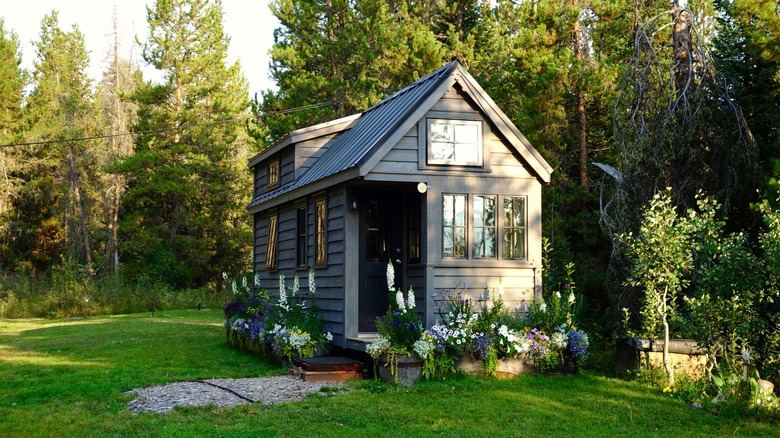The Worst States To Live In If You Have A Tiny House
The benefits of living in a tiny house are substantial, and making the change to a smaller living space can open up a world of benefits for your health and lifestyle. According to The Architect's Diary, these advantages include the ease of cleaning a smaller space, lower mortgage costs, and cheaper utility bills. But one of the top benefits is the peace of mind that comes from streamlining your life to the fewer possessions you genuinely value. More Americans are embracing the decision to make the change to tiny living. However, a number of states are still making it difficult for owners of small homes to put down roots.
Finding a spot for your tiny home is difficult because of two main factors: building codes and zoning regulations (via Tiny House Society). These rules are not the same in each state and even differ between counties. While no state explicitly declares a ban against tiny homes, its codes and regulations may be impossible to reconcile. For example, your small home might meet a building code requirement for ceiling height, but zoning restrictions might make it illegal to place the house on a property, even if it's yours, per Green Matters. For that reason, we researched states that are most unfavorable to tiny home dwellers, ranked from difficult to almost impossible.
New York
Tiny homes are permitted in some areas of upstate New York, such as Buffalo, where Nolo states that adding an ancillary building is lawful because it's referred to as a carriage house. However, restrictions across the state still make it difficult for the tiny house movement to take hold. One primary reason is that the requirement for additional parking spaces to accompany a new acquisition can be an impossibility, especially in places such as New York City, via The City. However, with its high cost of living and compact living quarters, New York City would greatly benefit from alternative housing opportunities.
Many experts in the field believe that tiny homes in New York are a great idea, including Deborah Gans, an architect at Gans Studio and a professor at Pratt Institute, per The City. The idea is "very doable," Gans says. "You can increase density while keeping the people already in the neighborhood in place." The architect adds that "there are neighborhoods in Queens, parts of Brooklyn and Staten Island that could really benefit and accommodate this." The future of tiny houses in New York will ultimately rest on the cooperation between residents who desire this change and the state and local governments who will make it come to pass.
Rhode Island
In Rhode Island, housing options have always been in high demand, and the opportunities currently available are out of reach for many budgets, per The Providence Journal. In addition to being one of the oldest states in the country, many of its buildings need repair. Rhode Island is researching new ideas to alleviate the urgent need for housing alternatives. Until now, tiny homes have been considered a lifestyle choice rather than a serious housing solution and have been disregarded as a viable option.
According to a 2019 law, an Accessory Dwelling Unit (ADU) is allowed on a property only if it is intended for the family of the unit, per SRCI. The state is taking steps to change the law to make it possible for non-family members to live in these ADUs. This step would open up housing options to a great number of people, via Tiny House Alliance USA. However, current zoning laws in Rhode Island complicate the matter. According to The Providence Journal, Shad Spencer, a city zoning administrator, indicates that the problem is that there's no clear way to classify a tiny home. Some options might be defined as mobile homes or RVs, and they cannot be placed permanently on a residential property. The obstacles to tiny homes in Rhode Island are clear, but the benefits of increased housing opportunities are becoming apparent as well.
Arkansas
Arkansas is filled with beautiful scenery, including Ouachita Mountain, Hot Springs National Park, and 52 state parks. The state's nickname is The Natural State, and it's easy to see why. Arkansas attracts those who love the outdoors and an independent way of life, per The Tiny Life. It's also easy to see why the tiny house movement would become a natural fit for a state that is already in tune with nature. However, significant inconsistency exists within the building codes between each city and county, making it a challenge for tiny home dwellers to put down roots.
For example, many tiny homes in Arkansas are considered to be RVs because they're on wheels, via Tiny House Society. As a result, these homes must be located within an RV or mobile home park. They are also considered part-time units and may not serve full-time residents. Another challenge to tiny home living in Arkansas is the size of the home. A tiny house is generally one that measures less than 600 square feet, via Porch. The city of Walnut Ridge imposes a limit on tiny homes to be no smaller than 600 square feet, per Utopian Villas. This restriction and others like it make it difficult for tiny home dwellers to find a place to call home in Arkansas. Given the state's appeal and the enthusiasm of the tiny home movement, however, the momentum to make these homes more accessible will certainly increase.
Connecticut
For years, Connecticut has ranked as one of the worst states for any homeowner trying to join the tiny home movement. The state boasts a beautiful way of life with a strong economy and low crime rate, and the natural beauty of the countryside draws people from far and wide to visit. Until recently, however, there were no opportunities for tiny home communities to spring up in this idyllic environment, per The Tiny Life. Every one of the state's 169 municipalities has different zoning regulations, and these rules have not been favorable toward the tiny home movement that is becoming more and more popular across America, via NBC Connecticut.
While tiny homes on wheels are allowed in some areas, they are considered camp trailers and are classified under the Connecticut Department of Motor Vehicles. This classification makes it difficult for the owner to make the home a full-time residence, according to The Tiny Life. The need for affordable housing in Connecticut is real, and advocates like Doug Werner from Tiny House Co. believe that building communities of tiny homes can be the solution. As Doug tells CT Insider, "It works for everybody, and everybody wins."




